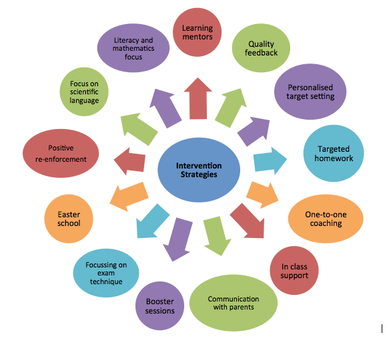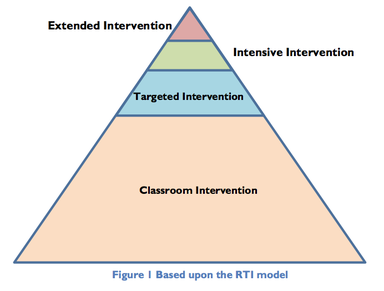
Common Barriers to Progress Include:
· Low attendance
· Social difficulties- poor self-esteem, difficulty working with others, feeling stressed or anxious
· Lack of academic aspiration
· Large misconceptions
· Lower progress as a result of inappropriate teaching methods, which don’t meet learning needs
· Poor behaviour
· Lack of challenge resulting in boredom and a lack of focus
· Underdeveloped learning skills – features such as poor listening, easily distracted, problems grasping cognitive needs in a whole class situation, poor literacy or mathematical skills
The diagram below highlights intervention strategies that can be implemented to enhance attainment, the majority of which can be employed during day-to-day teaching.

Struggling Students Benefit from Classroom Intervention Strategies that….
1. Include explicit, well-organized (systematic) instruction as well as opportunities to consolidate information;
2. Are provided in small-group or one-on-one formats;
3. Small timeframe provision on a regular basis
4. Provide extended opportunities for practice, including guided, independent, and cumulative practice with teacher feedback;
5. Are provided in addition to regular classroom practice;
6. Include continuous progress monitoring.

Tier 2 – Strategic Interventions should help Some Students, an additional 15% of students.
Tier 3 – Intensive Interventions should target A Minority of Students, 5% of students
Tier 4 – Extended Intervention will apply to a Few Students, approximately 2%
Oral Feedback
A suggested sequence for giving individual oral feedback in a planned review as intervention
- Plan feedback which is positive and specific
- Reinforce the value and importance of the pupils’ contribution
- Focus on recent learning objectives and learning outcomes in the context of pupil targets
- Give the pupil(s) time to reflect and respond
- Encourage the pupil(s) to ask questions to clarify their understanding of the progress they have made
- Identify and agree the most important next steps in learning and revise pupil targets if necessary
- Agree immediate and longer-term actions. Clarify when these will be reviewed, by whom, and what evidence will be sought
Written Feedback:
In order to improve the quality of feedback there must be explicit expectations about it. Teachers need to explain to pupils that, in line with whole-school policy:
- Students receive feedback on their work periodically and selectively
- Feedback focused on key priorities [the learning objectives]
- Feedback identifies what they need to do to improve
- Seeking help is an essential part of their learning and leads to useful discussion about ways of learning
- Feedback will require interactivity/action by the pupil
- All feedback needs to be positive and specific.
- Feedback is even better if linked to curriculum targets eg grade requirements.
- Taking the time over constructive comments reaps rewards with student performance.
- Mark less to achieve more!!!
Target setting:
The purposes of target setting:
- To use sources of information, including attainment data, to focus plans on raising standards of pupil attainment.
- To ensure pupils’ prior attainment and achievement is built upon throughout the key stage.
- To identify and focus teaching on areas of underperformance.
- To actively support improved learning outcomes for underachieving groups of pupils.
- The majority of GCSE subjects have pre-published sheets to aid students with their revision, using curricular targets.
- Checklists can be created for all units of work and are helpful in reinforcing grade differences.
- Persistent use of revision booklets reinforces good revision habits in students
- Students need to be encouraged to set, and record, their own curricular targets.
- Students need to be given opportunities to self-assess their own coursework and make any amendments if required.
- It is vital that coursework pieces, once marked, are shared with the students so that they know how to improve on any future pieces

 RSS Feed
RSS Feed
